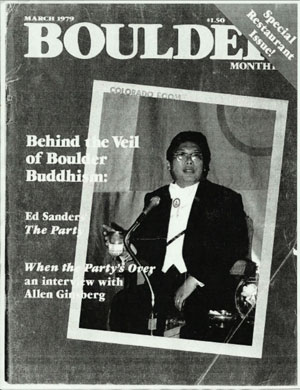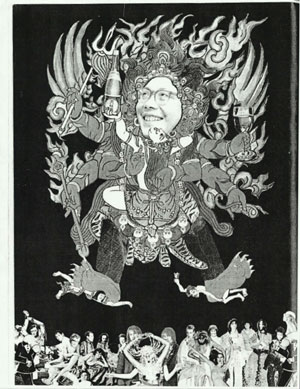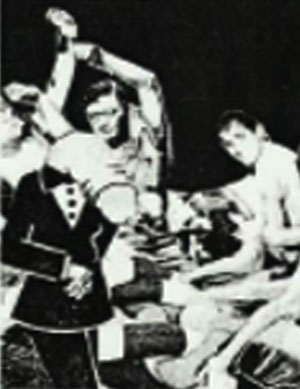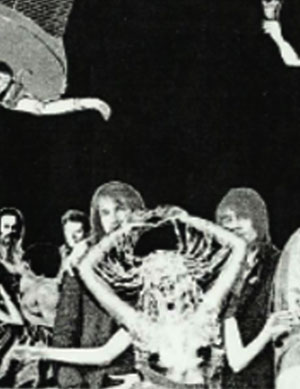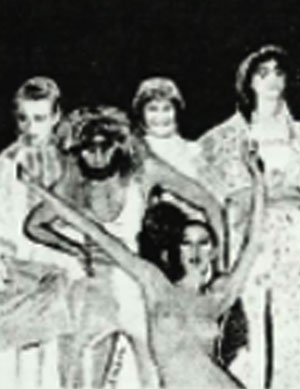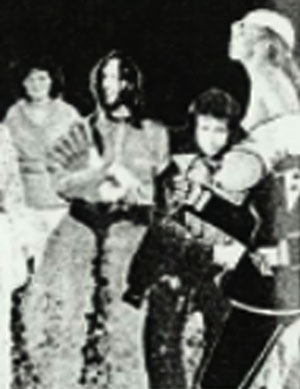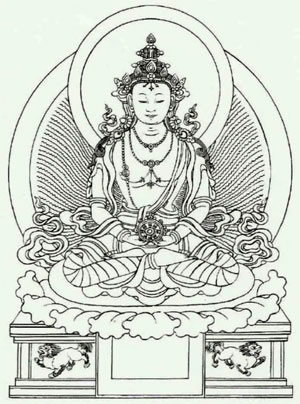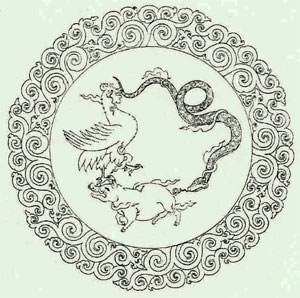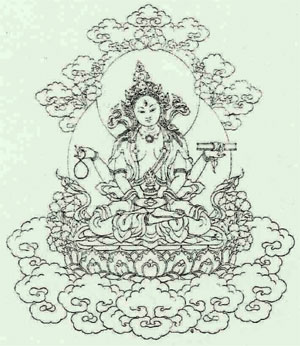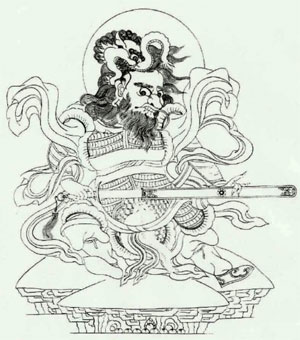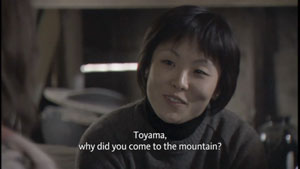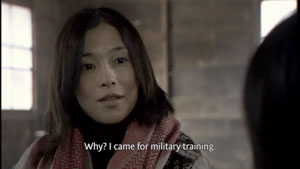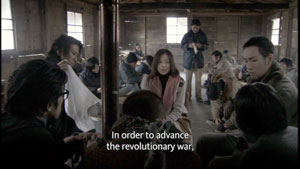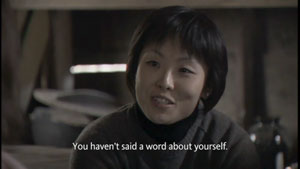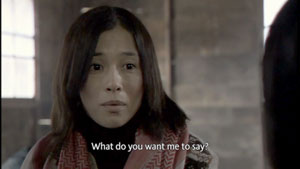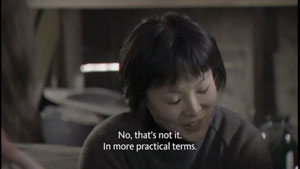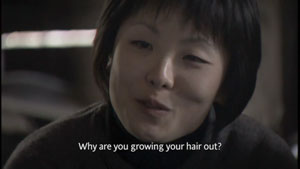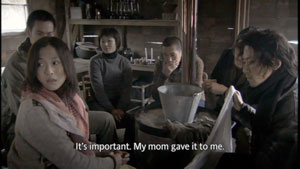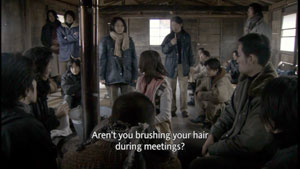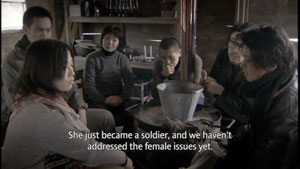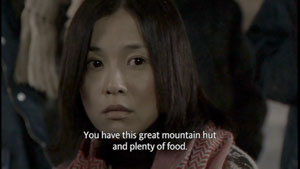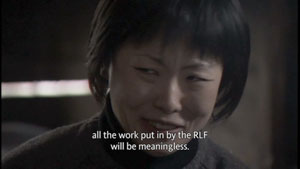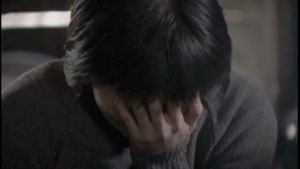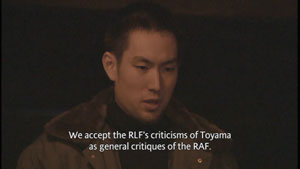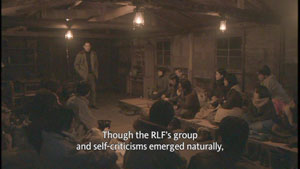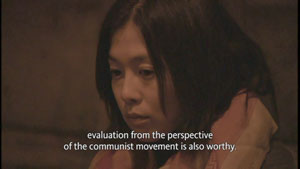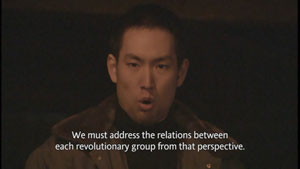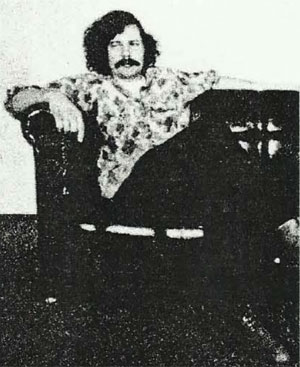Re: Former teacher at Boulder's Shambhala accused of sexuall
Part 1 of 2
Can Killing a Living Being Ever Be an Act of Compassion? The analysis of the act of killing in the Abhidhamma and Pali Commentaries
by Rupert Gethin
Centre for Buddhist Studies
Department of Theology and Religious Studies
University of Bristol
E-mail: Rupert.Gethin@bristol.ac.uk
NOTICE: THIS WORK MAY BE PROTECTED BY COPYRIGHT
Abstract: In the Theravadin exegetical tradition, the notion that intentionally killing a living being is wrong involves a claim that when certain mental states (such as compassion) are present in the mind, it is simply impossible that one could act in certain ways (such as to intentionally kill). Contrary to what Keown has claimed, the only criterion for judging whether an act is “moral” (kusala) or “immoral” (akusala) in Indian systematic Buddhist thought is the quality of the intention that motivates it. The idea that killing a living being might be a solution to the problem of suffering runs counter to the Buddhist emphasis on dukkha as a reality that must be understood. The cultivation of friendliness in the face of suffering is seen as something that can bring beneficial effects for self and others in a situation where it might seem that compassion should lead one to kill.1
Killing and Buddhist Ethics
In a number of contexts, the discourses of the Buddha that have come down to us in the four Pali Nikayas present the act of killing a living being as an unwholesome (akusala) act and, as such, to be avoided. The first of the ten courses of unwholesome action (akusala-kammapatha) is “to kill living beings.” The third of the eight elements that make up the Buddha’s eightfold path is “right action”; one of the three forms that right action takes is “refraining from killing living beings.” The first of the five precepts or “rules of training” (sikkhapada) that are undertaken by all lay Buddhists takes the form, “I undertake the rule of training to refrain from harming living beings.” The ten courses of unwholesome action, the eightfold path, and the five precepts are all standard elements in the teaching of the Buddha as presented in the Pali Nikayas. But we also find the injunction not to kill or harm living beings spelled out in other ways and in specific contexts. Let me cite just two of the many possible examples. In the Brahmajala Sutta we are told how the Buddha “refrains from killing living creatures, discards sticks and swords, and is considerate and full of concern, remaining sympathetic and well disposed towards all creatures and beings.”2 And a verse from the Suttanipata (394) states, “Laying aside violence in respect of all living beings in the world, both those which are still and those which move, he should not kill a living creature, not cause to kill, nor allow others to kill.”3 In the Cula-Kammavibhanga Sutta we are told of the results of killing living beings:
The well known Metta Sutta or “discourse on friendliness,” a text frequently chanted in Buddhist ritual and considered one that brings protection or safety (paritta), sums up the positive corollary of not killing living beings as follows:
So, prima facie, the picture is clear: killing living beings — any living being — is a bad thing that leads to an unpleasant rebirth; following the Buddha’s path involves refraining from killing living beings, laying aside weapons, and cultivating the compassion of the Buddha — end of story. But, one might ask, are all kinds of killing the same? Is there not a difference between killing a human being and squashing a mosquito? And what of our motivations in killing? Is “putting down” an ailing cat or dog not rather different from, say, hunting animals for sport? What of acts of “mercy-killing” or euthanasia in the case of the sick and dying? What of abortion? What of war? While not all these questions are directly and explicitly addressed in traditional Buddhist writings, a number of statements and discussions in the Pali texts touch on these issues in various ways.
In recent years a number of scholars have drawn on some of these discussions in order to try to begin to map out something of the traditional Buddhist approach to some of the ethical issues surrounding the act of killing, and also to introduce a Buddhist perspective into the contemporary discussion of such issues as abortion, euthanasia, and general bioethics.6 While this work has certainly succeeded in clarifying Buddhist thinking on ethical issues, I also think that by too readily transposing Buddhist discourse into the framework of contemporary ethical discourse it has sometimes inadvertently distorted what I see as the distinctively Buddhist psychological take on ethical issues.
I do not mean to suggest here that the scholars working in this area have got their Buddhist ethics wrong, but rather that they tend at crucial points to force Buddhist texts to conform to the idiom of contemporary ethical discourse, rather than allowing them their own distinctive voice. One reason for this, I think, is because existing discussions do not pay sufficient attention to the Pali commentaries and Abhidhamma framework in which their discussions of the finer points of Buddhist thought are set. The basic relevance of the Abhidhamma to what in the Western intellectual tradition is called “ethics” was in fact recognized a century ago by Mrs. Rhys Davids when she translated the first book of the Abhidhamma Pitaka under the title of Buddhist Psychological Ethics.7 The present paper is in part an attempt to follow her lead and consider more fully some details of the treatment found in the Theravada Abhidhamma and Pali commentaries of one particular unwholesome course of action and the related training rules in the Vinaya.
The Vinaya Rules
The monastic code for Buddhist monks includes 227 rules; these are divided into groups according to the seriousness of the offence that follows from breaking the rule. The first four, the parajikas, are the most serious: breaking any one of them involves the monk in “defeat” (expulsion from the order).8 The third of the parajika offences is a rule against intentionally killing another human being:
Killing a living being other than a human being is distinguished as a lesser offence (pacittiya sixty-one): “If any bhikkhu should intentionally deprive a living being of life, there is an offence entailing expiation.”10
Two things are clear in the formulation of these rules: (1) that whether or not we do things intentionally and with full consciousness is a crucial determinant of responsibility in the Buddhist view of things; (2) killing a human being is to be distinguished from killing other living beings.
Of course, we must tread carefully here. The canonical and commentarial Vinaya texts are not simply concerned with ethical issues and matters of morality; they are also concerned with legal questions — with how to determine whether or not a monk or nun has broken one of a set of 227 or 311 rules. As the texts are well aware, breaking a rule of law may or may not be the same thing as doing a moral wrong. The ancient Buddhist texts make a clear distinction between that which is loka-vajja and that which is pannatti-vajja — deeds that offend against a universally accepted moral principle and those that offend against a conventionally designated rule. I shall return to this distinction presently.
If we examine the Vinaya texts and the “case histories” (vinita-vatthu) that accompany the various rules, the question of a monk’s intentions and of his state of mind is raised again and again in determining whether or not a rule has been broken: accidentally killing someone or killing someone when one is in a confused state of mind is quite a different matter from deliberately and consciously killing someone. Of course, the importance of intention in the Buddhist understanding of what constitutes moral or immoral action is brought out in an often quoted statement of the Buddha’s: “It is intention that I call action (kamma); having formed an intention one acts.”11 In other words, actions that carry moral responsibility — which will lead to pleasant or unpleasant results — are those which one does with clear intention.12 As in a modern court of law, intentions and state of mind are important considerations.
The old Vinaya exposition (vibhanga) of the third parajika offence also gives us some other details and clues: encouraging someone to commit suicide who then does so, carrying out an abortion or intentionally being instrumental in an abortion are both considered as constituting intentional killing of a human being and hence an offence involving “defeat” or “expulsion” (parajika).13
The Commentarial Discussion
There are two main contexts in which the Pali atthakathas provide an analysis of the act of killing a being: (1) in commenting on the list of ten akusala-kammapatha;14 (2) in commenting on the third parajika rule and pacittiya sixty-one.
Let us turn first to the commentarial analysis of the “courses of action.” In their treatment of the courses of action, the commentaries imply a distinction between kamma in general — any good or bad action that carries some degree of moral responsibility and which will have a desirable or undesirable result — and kamma-patha — a complete course of action. This last expression characterizes a completed and fully intentional morally good or bad action. The distinction at work here is perhaps comparable to the distinction made between venial and mortal sin in medieval Christian theology. So what do the commentaries have to say about what is involved in the course of action of killing a living being? The following passage occurs in at least five places in the atthakathas, which no doubt indicates that it has been drawn from the earlier Sinhala commentaries as an authoritative statement of the relevant issues. In part it seems in turn to have drawn on and developed discussions found in the canonical Vinaya analysis of the third parajika.15
So for the killing of a living being to be classified as a kamma-patha, five conditions need to be fulfilled. If any one of the five conditions is not fulfilled, then it is not a completed course of action, although it may still be an unwholesome or immoral act of some sort and degree. From this idea it would seem to follow that any intentional killing of any living being whatsoever should be regarded as an unwholesome course of kamma, and as morally blameworthy. I will return to the question of intention presently. First I wish to consider briefly the three factors the commentary singles out as affecting the degree of seriousness or moral blameworthiness of the deed:
• Size: in the case of animals, the bigger the animal, the more serious the act of killing.
• Virtue: in the case of humans, the more virtuous the human, the more serious the act of killing.
• The intensity of the desire to kill coupled with the effort involved in the actual act of killing.
These criteria have been briefly discussed by Damien Keown.18 His discussion seems to assume that these factors are offered as a more or less exact way of calculating the relative blame that accrues to unwholesome deeds. But to read them in this way may land us in unnecessary difficulties. I would prefer to take them as articulating what is in many ways a “common sense” attitude towards the relative blameworthiness of different unwholesome acts — an attitude that has much in common with the attitudes of a contemporary court of law.
The first criterion is something that I would argue is taken for granted in contemporary society. Most of us would regard the swatting of a fly or a mosquito as different and qualitatively distinct from the killing of a mouse or rat; most would regard the killing of a mouse or a rat as different and qualitatively distinct from the killing of a horse, gorilla, or elephant. As long as we take the question of size as a general rule of thumb, and not as a strict and exact method of calculating moral blame, it would seem to work. Of course, some might want to argue that although we certainly do regard the killing of mosquitoes in a different light from that in which we regard the killing of, say, horses or humans, this difference is really just a measure of our moral confusion: in truth we really should not, since all life is of equal moral worth.
At first sight the second is more difficult and, some might feel, a more morally dangerous if not positively morally repugnant idea because it might be taken as allowing us to conclude that those whom we consider as morally degenerate are somehow morally less valuable, and so can be disposed of with impunity. I would suggest that this is the wrong conclusion. The view expressed here is that killing living beings is always wrong, and never right.
What the commentary is trying to get at, I think, is the psychological attitude, the quality of intention that might be involved in killing different human beings: that is, we tend to feel differently about and find it harder to understand — and perhaps regard as more blameworthy — the killing of innocents than we do the killing of some serial murderer, for example. Think for a moment of the murder of “a sweet old lady” who had never done anyone any harm and of the murder (or execution) of some notorious criminal; imagine for a moment the assassination of Adolf Hitler or Joseph Stalin alongside that of Mahatma Gandhi or Martin Luther King.
The third criterion seems to have to do with the interplay between the viciousness and depravity of the act of killing; compare killings that are acts of uncharacteristic and sudden anger with those that are premeditated, sadistic acts. The relationship between effort and the intensity of the defilements is no doubt of some complexity: a casual act of killing without any thought for the victim might involve little effort and thought, yet that very fact might be taken as an indicator of deep-rooted and strong defilements.
Of course, in matters of morals we like to think that we can find universals, and the preceding discussion raises all sorts of questions about the extent to which we have to do here with socially and culturally conditioned values as opposed to universal human and moral values. Different cultures, different societies, have quite different attitudes towards certain animals. But whatever we precisely think of the moral suitability of the criteria suggested, we at least can see that the commentaries are attempting to articulate an attitude which views killing living beings as in all circumstances an unwholesome kamma, an action leading to unpleasant results in future births, but nevertheless allows that some acts of killing are worse than others.
The Intention to Kill: The Abhidhamma Perspective
The particular detail of the commentarial analyses that I wish to focus on in the present context is the way that “killing a being” is defined not as the actual act of killing itself but as the mental intention or will (cetana) that prompts the act of killing:
Or, as the Samantapasadika puts it, “The intention to kill as a result of which one produces the activity that cuts off [a being’s] life-faculty is called ‘killing a living being’; ‘the one who kills a living being’ should be understood as the person possessing that intention.”19
In both these commentarial passages, in line with the general tendency in Buddhist thought, the emphasis is on an unwholesome action (kamma) as consisting at least in part in the underlying mental intention (cetana). While the commentaries do not state the intention to kill as a sufficient condition for the course of action that is killing a living being, they do clearly state it as one of the five necessary conditions (sambhara): a living being, awareness of the living being, a mind that intends to kill, the exertion, and death as a result.
In the present context, what I wish to establish is the Theravada analysis of the nature of the mind that might produce in someone the intention or will to kill: what kinds of motivation might characterize the mind at the time of killing? In fact, within the general framework of Abhidhamma psychology, the commentarial analysis of the nature of the intention to kill (vadhakacitta/ vadhaka-cetana) seems clear and unambiguous.
After the initial analysis of the ten akusala kammapathas, the commentarial analysis sets out five ways for defining (vinicchaya) their nature: by way of intrinsic nature (dhamma/sabhava), grouping (kotthasa), object (arammana), feeling (vedana), and root (mula). For present purposes, it is the definition by way of feeling and root that is particularly relevant. The definition by way of intrinsic nature reaffirms the point already made, namely that the act of killing is essentially the intention to kill.20 When it comes to the definition of killing a being by way of feeling, it is stated that it “has painful feeling, for even though kings presented with a thief say with a smile, “Go and execute him,” nevertheless the decisive intention (sannitthapaka-cetana) is only associated with painful feeling.”21 As to root, killing a living being has two roots, namely hate and delusion.
This set of definitions keys the kamma-pathas quite precisely into the Abhidhamma system of classes of consciousness. The fact that intention to kill is accompanied by only painful feeling and has as its roots hate and delusion means that it can only be constituted by two of the standard list of eighty-nine classes of consciousness: the two classes of sense-sphere consciousness rooted in hate and accompanied by unhappiness.22 The possibility that the intention to kill might ever be constituted by one or other of the eight classes of sense-sphere consciousness rooted in lack of greed, lack of hate, and lack of ignorance is apparently simply excluded. In other words the intention to kill is understood as exclusively unwholesome, and the possibility that it might ever be something wholesome prompted by thoughts of compassion is not countenanced.
Of course, one might try to argue that wholesome minds are not included here by definition: what is under discussion here are the ten courses of unwholesome action, and if one kills a living being out of compassion it is by definition not an unwholesome course of action and hence not “killing a living being” (panatipata). But, as we shall see, the way in which the Vinaya does allow for the fact that some rules can be broken with wholesome (kusala) and undetermined (avyakata) consciousness seems to exclude this interpretation. In the Sutta context, the point is that there simply is no wholesome course of action that is killing a living being.
The two older extant commentaries to the Vinaya, the Samantapasadika and the Kankhavitarani, give a set of eight categories by which to analyze each rule of the Patimokkha.23 These categories concern (1) the nature of the “arising” or “origin” of an offence (samutthana); (2) whether it arises from activity (kiriya) or inactivity; (3) whether there needs to be full awareness (sanna) of what one is doing (or not doing) for something to constitute an offence;24 (4) whether the mind (citta) is involved in the offence’s arising or origin; (5) whether an offence constitutes something that is universally a fault (loka-vajja) or whether it is something that is merely a fault by designation (pannatti-vajja) as such in the Vinaya;25 (6) whether an offence concerns an act (kamma) of body, speech, or mind; (7) whether at the time of committing an offence one’s mind is constituted by unwholesome consciousness, or by either wholesome or undetermined consciousness;26 and (8) whether the mind at the time of committing an offence will be associated with unpleasant feeling, pleasant feeling, or neutral feeling.27
The seventh and eighth categories in this list once again key into the Abhidhamma classification of consciousness. The Samantapasadika makes this quite explicit:
What this makes clear is that for the Samantapasadika, while in many circumstances Vinaya rules will be broken, as one might expect, when the mind is constituted by unwholesome consciousness and motivated by some combination of greed, hatred, and delusion, at least certain rules in certain circumstances may be broken when the mind is constituted by wholesome consciousness and motivated by nonattachment, friendliness, and wisdom. Moreover, this being the case, it is explicitly stated that again at least certain rules in certain circumstances may be broken when the mind is constituted by various classes of undetermined or kiriya consciousness. In other words, the Vinaya commentary recognizes that in certain circumstances a purely wholesome (kusala) intention will lead someone to break a Vinaya rule; even arahats in certain circumstance will — quite rightly and properly in that they are acting from the motivations of nonattachment (alobha), friendliness (adosa), and wisdom (amoha) — break Vinaya rules. In the course of commenting on the 227 rules of the Patimokkha the Samantapasadika and Kankhavitarani spell out which rules can be broken when the mind is constituted by these different types of consciousness. Commenting on the third parajika, the Samantapasadika states:
In the case of Pacittiya sixty-one, Samantapasadika makes the following comment:
The fact that the Vinaya commentary does not allow for the possibility that one might break these two Vinaya rules when the mind is constituted by anything other than unwholesome consciousness and associated with anything other than painful feeling makes it clear that it considers only two of the eighty-nine classes of consciousness as relevant to the breaking of these rules: the two sense-sphere consciousnesses rooted in aversion/hate (dosa) and accompanied by unhappiness.32 As we are here dealing with the motivations for breaking a legal rule rather than for an ethical rule, the possibility that wholesome consciousness is not considered as a motivation by definition, as in the case of the unwholesome courses of kamma, seems to be excluded.
The case of the laughing king cited here was also cited in the commentarial analysis of the kamma-patha. Its significance might be interpreted in two slightly different ways: (1) even a king who takes pleasure in ordering the execution of criminals, at the moment he orders the execution does so with unwholesome consciousness motivated by aversion; (2) even a king merely carrying out the duties of government, at the moment he orders the execution of a criminal does so with unwholesome consciousness motivated by aversion.
According to Abhidhamma theory, beings may smile or laugh with any of the thirteen sense-sphere consciousnesses accompanied by happy feeling: four unwholesome, four wholesome, and five kiriya.33 The four unwholesome are rooted in greed (happy feeling never accompanies consciousness rooted in aversion); the four wholesome are rooted in nonattachment and friendliness or nonattachment, friendliness and wisdom, likewise four of the five kiriya; arahats and Buddhas may in addition smile with the unmotivated consciousness that produces smiles. The point the commentary seems to want to make here — and, as we saw above, in the context of the unwholesome course of kamma that constitutes killing a living being — is that while unwholesome consciousness rooted in greed and accompanied with happy feeling may arise close to the time of the intention to kill and thus superficially appear to be directly and immediately associated with an act of killing, this is not strictly the case: the actual intention that directly leads to the act of killing is always motivated by some kind of aversion and hence accompanied by unhappy feeling. What is revealed here then is what, in the Abhidhamma view of things, is a fundamental principle of the way in which the mind and intention operate.
The Abhidhamma appears quite uncompromising here: it is a psychological impossibility, a psychological contradiction in terms that one should, when motivated by nonattachment, friendliness (and wisdom), intentionally kill another living being.34 The Abhidhamma and Theravadin exegetical tradition just do not seem to countenance the possibility.35
Compassion as a Motive for Killing
Given that in contemporary discussions of euthanasia (both in the case of sick animals and dying human beings) and abortion, a motivation of compassion is at least partly appealed to by those seeking an ethical justification,36 it seems worth trying to pursue the question of just why the Abhidhamma traditions puts forward what might appear a somewhat uncompromising view. How does this view fit within the broader framework of the values that underpin Buddhist thought and practice?
The case histories that the canonical Vinaya appends to each of the rules of the Patimokkha outline several situations that are potentially relevant to the issue of euthanasia. These have been discussed by Damien Keown and others.37 In the present context I would like to focus on the one instance where the motivation associated with the breaking of the third parajika offence is explicitly stated to be compassion (karunna):
In his analysis of this case,39 Damien Keown argues that since the Buddha rules that the monks are guilty of a parajika offence despite their having acted out of compassion, it shows that the motivation of an act — here the good motivation of compassion — is an insufficient condition for determining whether an act is moral or immoral in Buddhist thought. Since the monks’ motivation is good, their wrongdoing must lie in something else.40 Keown suggests that the solution to the puzzle is to be found by employing a legal distinction between motivation and intention: the monks’ motive (compassion) is good, but what they intend (the death of the sick monk) is bad. Intending the death of the sick monk is bad because “it involves intentionally turning against a basic good,” the basic good in question being “karmic life.” So,
It seems to me that Keown’s analysis of this case is a prime example of the problem I referred to at the beginning of this article: distorting Buddhist ethical discourse by slipping into a contemporary idiom in which the categories are derived from a quite different and specific tradition of ethical discussion. A concept such as “basic good” is not found in the Pali Buddhist texts; by using it and driving a wedge between “moral rightness” and “motive,” Keown begins to talk in terms and categories that lack a firm foundation in Buddhist thought, at least as expounded in the Pali canon and its oldest extant commentaries. For these texts, the concepts of moral right and moral wrong can only meaningfully be discussed in terms of what is kusala and akusala, what is wholesome and unwholesome.42 And the terms kusala and akusala are not applied with reference to “basic goods” such as “karmic life” in Buddhist thought; they are applied to the particular mentalities (cetasika) that motivate the mind and thus lead to acts of body and speech. In order to determine an act as “moral” or “immoral” in the framework of Buddhist thought assumed by the Pali commentarial tradition, we have to ask whether it is kusala or akusala, and this is a question about the nature of the motivations (hetu) that function as the roots (mula) of and so underlie the intention or will (cetana) to act, nothing else. The Theravadin Abhidhamma defines these motivations or roots as essentially six in number: greed (lobha), hatred (dosa), and delusion (moha) on the unwholesome or akusala side; and lack of greed (alobha), lack of hatred (adosa), and lack of delusion (amoha) on the wholesome or kusala side.43 The latter three are understood as positive virtues equivalent to generosity (dana), friendliness (metta) and wisdom (panna).44 What I wish to argue is that, contrary to Keown, for Theravada Buddhist thought it is indeed impossible to do wrong (such as perform an act that is akusala) from an immediate motive that is good (kusala).
In his discussion of the Vinaya case referred to above, Keown cites the Samantapasadika’s comments, although he does not quote these in full, and, in part as a consequence, his understanding of these is, I think, flawed. The following is a full translation:
The term antara, which I have translated as “prematurely,” Keown renders as “shortly after.” But as A Critical Pali Dictionary points out, antara can have the connotation of “untimely,”46 and the specific background to the Samantapasadika’s comments here is surely the technical notion of timely (kala-) and untimely death (akala-marana). As the Visuddhimagga states, one of the factors in determining death as timely or untimely is the exhaustion or otherwise of a being’s natural lifespan (ayus).47 Only if one understands antara as “prematurely” does the sense of the statement about one course of impulsion being all that remains of life (eka-javana-varavasese pi ayusmim) become clear — and also the point made subsequently which Keown omits) about the monk dying in accordance with his lifespan (yathayuna).
Having cited the Samantapasadika’s comments on this Vinaya case, Keown himself goes on to comment that the monks’ motivation in speaking in praise of death in the present context “is not in question since we are explicitly told that they acted out of compassion.” However, the Samantapasadika precisely does question the motivation of compassion here, in the first place with the following significant clause: maranatthika va hutva maranatthika-bhavam ajananta. Keown renders this “they made death their aim. . . although ignorant of the state of being one who makes death his aim,” explaining in a note that “this is because no case of this kind had arisen hitherto, and the implication of their actions occurred to them after the death of the patient.”48 I think this rendering represents a misunderstanding. Above, I have rendered this clause “wanting his death yet not realizing that his death is what they wanted.” The subcommentaries explain the clause as meaning that the monks in question did not know their own state of mind of intending death, and were thus not aware of the nature of the consciousness that had arisen in their own minds.49 In other words, they wanted the sick monk’s death, but lacked the self-awareness to see that this is what they wanted. This view of the matter is consonant with the observation regarding the king who superficially appears to be ordering the execution of a criminal with a mind accompanied by pleasant feeling, when in fact according to the psychological analysis of Abhidhamma, the decisive state of mind must be accompanied by unpleasant feeling. In precisely the same way the commentary and subcommentaries want to suggest that although the monks in the present case think they are acting out of compassion and only have the dying monk’s welfare at heart, if they were able to see their motivations more clearly they would see that in fact this was not so.
Thus the commentary goes on to state quite explicitly that when it is said the monks spoke in praise of death out of compassion, this is said “by way of the common way of speaking” (vohara-vasena). Significantly, Keown omits this sentence from his quotation. But, in the light of our earlier discussion, it is quite clear why the Samantapasadika says this. For the Samantapasadika, it simply cannot be that the mind that directly intends the death of a living being is other than one of the two classes of unwholesome consciousness rooted in aversion; and the mental factors (cetasika) of friendliness (adosa, metta) and compassion (karuna, karunna) cannot be associated with such a consciousness. As the subcommentaries explain, that these monks acted out of compassion is said with reference to their earlier motivation, because compassion is absent at the moment of the decisive intention in one who intends death; so the present case is precisely not like the setting free out of compassion of a boar caught in a trap.50
While it is impossible to demonstrate conclusively that the Samantapasadika’s and subcommentaries’ understanding of the situation conforms to the spirit of the original Vinaya case, it is clear that Keown’s suggestion that this case shows that for Buddhism “a good motive is thus a necessary but not a sufficient condition for a moral act”51 does not hold good for the Theravadin Abhidhamma and exegetical tradition. Indeed, I think his attempt to employ a legal distinction between motive and intention (“if I kill you from the motive of compassion . . . I nevertheless intend to kill you”)52 in the present context is misconceived. I am not suggesting that the distinction is necessarily an invalid one in a Buddhist Abhidhamma framework, merely that in that framework it is considered psychologically impossible to intend to kill someone when motivated by compassion. Thus I am not convinced that there is a concept of “karmic life” as a “basic good” in mainstream Indian Buddhist thought as he maintains.53
The manner in which the commentary understands the present case as an instance of parajika is clear: it fulfils the conditions for being classified as an unwholesome course of action. There is a living being, the monks are fully aware that he is a living being, they intend that the sick monk should die, they carry out the necessary action in speaking in praise of death to the sick monk, and the sick monk dies as result of their action. Moreover the commentary simply does not allow that the decisive (sanitthapaka) intention or motivation is one of compassion (karunna). The decisive intention in this case — as in all cases of intentionally killing a living being — is to be understood in terms of one of the two classes of consciousness rooted in aversion and accompanied by unpleasant feeling.
It is important to note, however, that this does not mean that in the Abhidhamma view of things the motive of compassion is necessarily completely divorced from each and every act of killing. The example adduced by the commentaries of a laughing king ordering the execution of a criminal reveals an understanding that allows for the rapid change from pleasant feeling to unpleasant feeling, and hence from greed to aversion in the motivations of the mind.54 Such a model of the way consciousness processes work suggests the possibility of situations where there is a similarly rapid change from wholesome consciousness to unwholesome consciousness, and if that is so the Abhidhamma model can accommodate the possibility of wholesome consciousnesses rooted in nonattachment and friendliness (with or without in addition wisdom) being relatively closely associated in time with an act of killing — indeed, as we have seen, this appears to be how the subcommentaries understand the Vinaya case we have just been considering. Thus it can appear — when the rapid flow of different consciousnesses is not closely examined — that in certain circumstances a being is killed simply out of compassion. Nevertheless, the possibility of the decisive (sanitthapaka) intention being motivated by these wholesome roots is simply ruled out. So while it is possible, on this view of the matter, that an act of killing a living being may in part be associated with compassion, the Abhidhamma wants to exclude the possibility that such an act could ever be wholly so: the arising of consciousness rooted in aversion at the decisive moment is a necessary condition of all intentional acts of killing. Hence that an awakened being — whether sammasambuddha or arahat — might intentionally kill a living being is not countenanced.
So why is it that the Theravada exegetical tradition wants to exclude compassion as the simple motivation for killing a living being? What is wrong with compassion as a motive for killing a living being? An initial answer to this question is apparent in the advice about what kind of instruction should be given to a sick monk. What the commentary suggests is that it is quite proper to recommend death to the dying as an occasion when there is a special opportunity for making crucial advances on the path: it is a time when the paths and fruits of stream-entry, once-return, never-return or even arahatship might be attained.55 But this opportunity is grasped not by actively hastening death, by willing the advent of death, but rather by renewing one’s commitment to one’s practice and cultivating mindfulness.
In taking up Keown’s discussion of the case of the sick monk, Peter Harvey gives only a partial rendering of the commentary’s advice;56 nonetheless, the conclusion he draws from it seems basically sound:
As Harvey’s observations suggest, the answer to why mainstream Indian Buddhist thought does not allow compassion as a motive for killing seems in part to lie with very fundamental Buddhist principles. As the first of the four truths or realities (sacca), suffering or dukkha is something that must be fully comprehended (parinneyya). And indeed the Nikayas’ shorthand definition of dukkha is the five upadanakkhandhas.58 Death, the breaking up of the khandhas, is an opportunity par excellence to understand the nature of dukkha, its arising, its ceasing, and the way leading to its ceasing. If in the case of deliberately hastening a sick being’s death, compassion and wisdom are excluded by the Abhidhamma from being considered the decisive motivations, then what we are left with as motivations are aversion and delusion. Aversion to what? The answer must surely be aversion towards the being’s suffering, which amounts to a refusal to face the reality of suffering with true compassion and wisdom. Killing the being is certainly a solution to the problem of suffering in this situation: by getting rid of the being who is suffering, it gets rid of the suffering. But in the Abhidhamma view of things it can hardly be a wise solution: it is rather a quick fix that precisely avoids confronting the problem of suffering, that precisely avoids looking at its true nature.59 So while on the Abhidhamma psychological model it is possible to envisage situations where at least some of the consciousnesses associated with an act of killing might be wholesome and genuinely motivated by the two or three wholesome roots, it would seem that the decisive motivation in such a case would be regarded as some form of refusal to face the reality of suffering — a reality that real wisdom and compassion faces up to.
The understanding that I have been trying to articulate on the basis of the ancient texts has been recently quite precisely stated in an essay on Thai Buddhist perspectives on euthanasia:
Can Killing a Living Being Ever Be an Act of Compassion? The analysis of the act of killing in the Abhidhamma and Pali Commentaries
by Rupert Gethin
Centre for Buddhist Studies
Department of Theology and Religious Studies
University of Bristol
E-mail: Rupert.Gethin@bristol.ac.uk
NOTICE: THIS WORK MAY BE PROTECTED BY COPYRIGHT
YOU ARE REQUIRED TO READ THE COPYRIGHT NOTICE AT THIS LINK BEFORE YOU READ THE FOLLOWING WORK, THAT IS AVAILABLE SOLELY FOR PRIVATE STUDY, SCHOLARSHIP OR RESEARCH PURSUANT TO 17 U.S.C. SECTION 107 AND 108. IN THE EVENT THAT THE LIBRARY DETERMINES THAT UNLAWFUL COPYING OF THIS WORK HAS OCCURRED, THE LIBRARY HAS THE RIGHT TO BLOCK THE I.P. ADDRESS AT WHICH THE UNLAWFUL COPYING APPEARED TO HAVE OCCURRED. THANK YOU FOR RESPECTING THE RIGHTS OF COPYRIGHT OWNERS.
Abstract: In the Theravadin exegetical tradition, the notion that intentionally killing a living being is wrong involves a claim that when certain mental states (such as compassion) are present in the mind, it is simply impossible that one could act in certain ways (such as to intentionally kill). Contrary to what Keown has claimed, the only criterion for judging whether an act is “moral” (kusala) or “immoral” (akusala) in Indian systematic Buddhist thought is the quality of the intention that motivates it. The idea that killing a living being might be a solution to the problem of suffering runs counter to the Buddhist emphasis on dukkha as a reality that must be understood. The cultivation of friendliness in the face of suffering is seen as something that can bring beneficial effects for self and others in a situation where it might seem that compassion should lead one to kill.1
Killing and Buddhist Ethics
In a number of contexts, the discourses of the Buddha that have come down to us in the four Pali Nikayas present the act of killing a living being as an unwholesome (akusala) act and, as such, to be avoided. The first of the ten courses of unwholesome action (akusala-kammapatha) is “to kill living beings.” The third of the eight elements that make up the Buddha’s eightfold path is “right action”; one of the three forms that right action takes is “refraining from killing living beings.” The first of the five precepts or “rules of training” (sikkhapada) that are undertaken by all lay Buddhists takes the form, “I undertake the rule of training to refrain from harming living beings.” The ten courses of unwholesome action, the eightfold path, and the five precepts are all standard elements in the teaching of the Buddha as presented in the Pali Nikayas. But we also find the injunction not to kill or harm living beings spelled out in other ways and in specific contexts. Let me cite just two of the many possible examples. In the Brahmajala Sutta we are told how the Buddha “refrains from killing living creatures, discards sticks and swords, and is considerate and full of concern, remaining sympathetic and well disposed towards all creatures and beings.”2 And a verse from the Suttanipata (394) states, “Laying aside violence in respect of all living beings in the world, both those which are still and those which move, he should not kill a living creature, not cause to kill, nor allow others to kill.”3 In the Cula-Kammavibhanga Sutta we are told of the results of killing living beings:
Some man or woman kills living beings and is murderous, has blood on his hands, is given to blows and violence, is without pity for living beings. Because of performing and carrying out such action, at the breaking up of the body, after death he reappears in a state of misfortune, an unhappy destiny, a state of affliction, hell.4
The well known Metta Sutta or “discourse on friendliness,” a text frequently chanted in Buddhist ritual and considered one that brings protection or safety (paritta), sums up the positive corollary of not killing living beings as follows:
One should not wish another pain out of anger or thoughts of enmity. Just as a mother would protect with her life her own son, her only son, so one should cultivate the immeasurable mind towards all living beings and friendliness towards the whole world.5
So, prima facie, the picture is clear: killing living beings — any living being — is a bad thing that leads to an unpleasant rebirth; following the Buddha’s path involves refraining from killing living beings, laying aside weapons, and cultivating the compassion of the Buddha — end of story. But, one might ask, are all kinds of killing the same? Is there not a difference between killing a human being and squashing a mosquito? And what of our motivations in killing? Is “putting down” an ailing cat or dog not rather different from, say, hunting animals for sport? What of acts of “mercy-killing” or euthanasia in the case of the sick and dying? What of abortion? What of war? While not all these questions are directly and explicitly addressed in traditional Buddhist writings, a number of statements and discussions in the Pali texts touch on these issues in various ways.
In recent years a number of scholars have drawn on some of these discussions in order to try to begin to map out something of the traditional Buddhist approach to some of the ethical issues surrounding the act of killing, and also to introduce a Buddhist perspective into the contemporary discussion of such issues as abortion, euthanasia, and general bioethics.6 While this work has certainly succeeded in clarifying Buddhist thinking on ethical issues, I also think that by too readily transposing Buddhist discourse into the framework of contemporary ethical discourse it has sometimes inadvertently distorted what I see as the distinctively Buddhist psychological take on ethical issues.
I do not mean to suggest here that the scholars working in this area have got their Buddhist ethics wrong, but rather that they tend at crucial points to force Buddhist texts to conform to the idiom of contemporary ethical discourse, rather than allowing them their own distinctive voice. One reason for this, I think, is because existing discussions do not pay sufficient attention to the Pali commentaries and Abhidhamma framework in which their discussions of the finer points of Buddhist thought are set. The basic relevance of the Abhidhamma to what in the Western intellectual tradition is called “ethics” was in fact recognized a century ago by Mrs. Rhys Davids when she translated the first book of the Abhidhamma Pitaka under the title of Buddhist Psychological Ethics.7 The present paper is in part an attempt to follow her lead and consider more fully some details of the treatment found in the Theravada Abhidhamma and Pali commentaries of one particular unwholesome course of action and the related training rules in the Vinaya.
The Vinaya Rules
The monastic code for Buddhist monks includes 227 rules; these are divided into groups according to the seriousness of the offence that follows from breaking the rule. The first four, the parajikas, are the most serious: breaking any one of them involves the monk in “defeat” (expulsion from the order).8 The third of the parajika offences is a rule against intentionally killing another human being:
Whatever bhikkhu should intentionally deprive a human being of life, or seek a weapon for him for taking [life], or should utter praise of death, or should urge him towards death saying, “Good man, what use to you is this miserable life? Death is better than life.” Or, having such thoughts and intentions in mind, should in several ways utter praise of death, or should urge him towards death, he too becomes defeated, is not in communion.9
Killing a living being other than a human being is distinguished as a lesser offence (pacittiya sixty-one): “If any bhikkhu should intentionally deprive a living being of life, there is an offence entailing expiation.”10
Two things are clear in the formulation of these rules: (1) that whether or not we do things intentionally and with full consciousness is a crucial determinant of responsibility in the Buddhist view of things; (2) killing a human being is to be distinguished from killing other living beings.
Of course, we must tread carefully here. The canonical and commentarial Vinaya texts are not simply concerned with ethical issues and matters of morality; they are also concerned with legal questions — with how to determine whether or not a monk or nun has broken one of a set of 227 or 311 rules. As the texts are well aware, breaking a rule of law may or may not be the same thing as doing a moral wrong. The ancient Buddhist texts make a clear distinction between that which is loka-vajja and that which is pannatti-vajja — deeds that offend against a universally accepted moral principle and those that offend against a conventionally designated rule. I shall return to this distinction presently.
If we examine the Vinaya texts and the “case histories” (vinita-vatthu) that accompany the various rules, the question of a monk’s intentions and of his state of mind is raised again and again in determining whether or not a rule has been broken: accidentally killing someone or killing someone when one is in a confused state of mind is quite a different matter from deliberately and consciously killing someone. Of course, the importance of intention in the Buddhist understanding of what constitutes moral or immoral action is brought out in an often quoted statement of the Buddha’s: “It is intention that I call action (kamma); having formed an intention one acts.”11 In other words, actions that carry moral responsibility — which will lead to pleasant or unpleasant results — are those which one does with clear intention.12 As in a modern court of law, intentions and state of mind are important considerations.
The old Vinaya exposition (vibhanga) of the third parajika offence also gives us some other details and clues: encouraging someone to commit suicide who then does so, carrying out an abortion or intentionally being instrumental in an abortion are both considered as constituting intentional killing of a human being and hence an offence involving “defeat” or “expulsion” (parajika).13
The Commentarial Discussion
There are two main contexts in which the Pali atthakathas provide an analysis of the act of killing a being: (1) in commenting on the list of ten akusala-kammapatha;14 (2) in commenting on the third parajika rule and pacittiya sixty-one.
Let us turn first to the commentarial analysis of the “courses of action.” In their treatment of the courses of action, the commentaries imply a distinction between kamma in general — any good or bad action that carries some degree of moral responsibility and which will have a desirable or undesirable result — and kamma-patha — a complete course of action. This last expression characterizes a completed and fully intentional morally good or bad action. The distinction at work here is perhaps comparable to the distinction made between venial and mortal sin in medieval Christian theology. So what do the commentaries have to say about what is involved in the course of action of killing a living being? The following passage occurs in at least five places in the atthakathas, which no doubt indicates that it has been drawn from the earlier Sinhala commentaries as an authoritative statement of the relevant issues. In part it seems in turn to have drawn on and developed discussions found in the canonical Vinaya analysis of the third parajika.15
The word “living creature” means, in conventional discourse, a being; in the ultimate sense it is the faculty of life. Killing a living creature is the intention to kill in one who perceives a living creature as such, when this occurs through the door of either the body or of speech and produces the exertion that cuts off the life-faculty [of that living being].]
In the case of living creatures without [moral] virtues, such as animals, [the act of killing] is less blameworthy when the creature has a small body, and more blameworthy when the being has a large body. Why? Because of the greater effort [required] in killing a being with a large body; and even when the effort is the same, [the act of killing a large-bodied creature is still more blameworthy] because of its greater physical substance. In the case of beings that possess [moral] virtues, such as human beings, the act of killing is less blameworthy when the being is of little virtue and more blameworthy when the being is of great virtue. But when the body and virtue [of creatures] are equal, [the act of killing] is less blameworthy when the defilements and force of the effort are mild, more blameworthy when they are powerful.
The act of killing has five components: a living being, the perception of the living being as such, the thought of killing, the action, and the death [of the being] as a result. There are six means:16 one’s own person, giving orders, missiles, stationary devices, magical spells, and psychic power.17
So for the killing of a living being to be classified as a kamma-patha, five conditions need to be fulfilled. If any one of the five conditions is not fulfilled, then it is not a completed course of action, although it may still be an unwholesome or immoral act of some sort and degree. From this idea it would seem to follow that any intentional killing of any living being whatsoever should be regarded as an unwholesome course of kamma, and as morally blameworthy. I will return to the question of intention presently. First I wish to consider briefly the three factors the commentary singles out as affecting the degree of seriousness or moral blameworthiness of the deed:
• Size: in the case of animals, the bigger the animal, the more serious the act of killing.
• Virtue: in the case of humans, the more virtuous the human, the more serious the act of killing.
• The intensity of the desire to kill coupled with the effort involved in the actual act of killing.
These criteria have been briefly discussed by Damien Keown.18 His discussion seems to assume that these factors are offered as a more or less exact way of calculating the relative blame that accrues to unwholesome deeds. But to read them in this way may land us in unnecessary difficulties. I would prefer to take them as articulating what is in many ways a “common sense” attitude towards the relative blameworthiness of different unwholesome acts — an attitude that has much in common with the attitudes of a contemporary court of law.
The first criterion is something that I would argue is taken for granted in contemporary society. Most of us would regard the swatting of a fly or a mosquito as different and qualitatively distinct from the killing of a mouse or rat; most would regard the killing of a mouse or a rat as different and qualitatively distinct from the killing of a horse, gorilla, or elephant. As long as we take the question of size as a general rule of thumb, and not as a strict and exact method of calculating moral blame, it would seem to work. Of course, some might want to argue that although we certainly do regard the killing of mosquitoes in a different light from that in which we regard the killing of, say, horses or humans, this difference is really just a measure of our moral confusion: in truth we really should not, since all life is of equal moral worth.
At first sight the second is more difficult and, some might feel, a more morally dangerous if not positively morally repugnant idea because it might be taken as allowing us to conclude that those whom we consider as morally degenerate are somehow morally less valuable, and so can be disposed of with impunity. I would suggest that this is the wrong conclusion. The view expressed here is that killing living beings is always wrong, and never right.
What the commentary is trying to get at, I think, is the psychological attitude, the quality of intention that might be involved in killing different human beings: that is, we tend to feel differently about and find it harder to understand — and perhaps regard as more blameworthy — the killing of innocents than we do the killing of some serial murderer, for example. Think for a moment of the murder of “a sweet old lady” who had never done anyone any harm and of the murder (or execution) of some notorious criminal; imagine for a moment the assassination of Adolf Hitler or Joseph Stalin alongside that of Mahatma Gandhi or Martin Luther King.
The third criterion seems to have to do with the interplay between the viciousness and depravity of the act of killing; compare killings that are acts of uncharacteristic and sudden anger with those that are premeditated, sadistic acts. The relationship between effort and the intensity of the defilements is no doubt of some complexity: a casual act of killing without any thought for the victim might involve little effort and thought, yet that very fact might be taken as an indicator of deep-rooted and strong defilements.
Of course, in matters of morals we like to think that we can find universals, and the preceding discussion raises all sorts of questions about the extent to which we have to do here with socially and culturally conditioned values as opposed to universal human and moral values. Different cultures, different societies, have quite different attitudes towards certain animals. But whatever we precisely think of the moral suitability of the criteria suggested, we at least can see that the commentaries are attempting to articulate an attitude which views killing living beings as in all circumstances an unwholesome kamma, an action leading to unpleasant results in future births, but nevertheless allows that some acts of killing are worse than others.
The Intention to Kill: The Abhidhamma Perspective
The particular detail of the commentarial analyses that I wish to focus on in the present context is the way that “killing a being” is defined not as the actual act of killing itself but as the mental intention or will (cetana) that prompts the act of killing:
Killing a living being is the intention to kill in one who is aware of a living being as a living being when this occurs through either the door of the body or of speech and produces the exertion that cuts off the life-faculty.
Or, as the Samantapasadika puts it, “The intention to kill as a result of which one produces the activity that cuts off [a being’s] life-faculty is called ‘killing a living being’; ‘the one who kills a living being’ should be understood as the person possessing that intention.”19
In both these commentarial passages, in line with the general tendency in Buddhist thought, the emphasis is on an unwholesome action (kamma) as consisting at least in part in the underlying mental intention (cetana). While the commentaries do not state the intention to kill as a sufficient condition for the course of action that is killing a living being, they do clearly state it as one of the five necessary conditions (sambhara): a living being, awareness of the living being, a mind that intends to kill, the exertion, and death as a result.
In the present context, what I wish to establish is the Theravada analysis of the nature of the mind that might produce in someone the intention or will to kill: what kinds of motivation might characterize the mind at the time of killing? In fact, within the general framework of Abhidhamma psychology, the commentarial analysis of the nature of the intention to kill (vadhakacitta/ vadhaka-cetana) seems clear and unambiguous.
After the initial analysis of the ten akusala kammapathas, the commentarial analysis sets out five ways for defining (vinicchaya) their nature: by way of intrinsic nature (dhamma/sabhava), grouping (kotthasa), object (arammana), feeling (vedana), and root (mula). For present purposes, it is the definition by way of feeling and root that is particularly relevant. The definition by way of intrinsic nature reaffirms the point already made, namely that the act of killing is essentially the intention to kill.20 When it comes to the definition of killing a being by way of feeling, it is stated that it “has painful feeling, for even though kings presented with a thief say with a smile, “Go and execute him,” nevertheless the decisive intention (sannitthapaka-cetana) is only associated with painful feeling.”21 As to root, killing a living being has two roots, namely hate and delusion.
This set of definitions keys the kamma-pathas quite precisely into the Abhidhamma system of classes of consciousness. The fact that intention to kill is accompanied by only painful feeling and has as its roots hate and delusion means that it can only be constituted by two of the standard list of eighty-nine classes of consciousness: the two classes of sense-sphere consciousness rooted in hate and accompanied by unhappiness.22 The possibility that the intention to kill might ever be constituted by one or other of the eight classes of sense-sphere consciousness rooted in lack of greed, lack of hate, and lack of ignorance is apparently simply excluded. In other words the intention to kill is understood as exclusively unwholesome, and the possibility that it might ever be something wholesome prompted by thoughts of compassion is not countenanced.
Of course, one might try to argue that wholesome minds are not included here by definition: what is under discussion here are the ten courses of unwholesome action, and if one kills a living being out of compassion it is by definition not an unwholesome course of action and hence not “killing a living being” (panatipata). But, as we shall see, the way in which the Vinaya does allow for the fact that some rules can be broken with wholesome (kusala) and undetermined (avyakata) consciousness seems to exclude this interpretation. In the Sutta context, the point is that there simply is no wholesome course of action that is killing a living being.
The two older extant commentaries to the Vinaya, the Samantapasadika and the Kankhavitarani, give a set of eight categories by which to analyze each rule of the Patimokkha.23 These categories concern (1) the nature of the “arising” or “origin” of an offence (samutthana); (2) whether it arises from activity (kiriya) or inactivity; (3) whether there needs to be full awareness (sanna) of what one is doing (or not doing) for something to constitute an offence;24 (4) whether the mind (citta) is involved in the offence’s arising or origin; (5) whether an offence constitutes something that is universally a fault (loka-vajja) or whether it is something that is merely a fault by designation (pannatti-vajja) as such in the Vinaya;25 (6) whether an offence concerns an act (kamma) of body, speech, or mind; (7) whether at the time of committing an offence one’s mind is constituted by unwholesome consciousness, or by either wholesome or undetermined consciousness;26 and (8) whether the mind at the time of committing an offence will be associated with unpleasant feeling, pleasant feeling, or neutral feeling.27
The seventh and eighth categories in this list once again key into the Abhidhamma classification of consciousness. The Samantapasadika makes this quite explicit:
There are wholesome rules, unwholesome rules and undetermined rules. For just thirty-two classes of consciousness can produce an offence: the eight wholesome sense-sphere consciousnesses, the twelve unwholesome and ten kiriya sense-sphere consciousnesses, 28 and the two wholesome and kiriya higher knowledge consciousnesses. A rule which one breaks with wholesome consciousness is [classified as] wholesome, [those which one breaks] with the other kinds are classified accordingly.29
What this makes clear is that for the Samantapasadika, while in many circumstances Vinaya rules will be broken, as one might expect, when the mind is constituted by unwholesome consciousness and motivated by some combination of greed, hatred, and delusion, at least certain rules in certain circumstances may be broken when the mind is constituted by wholesome consciousness and motivated by nonattachment, friendliness, and wisdom. Moreover, this being the case, it is explicitly stated that again at least certain rules in certain circumstances may be broken when the mind is constituted by various classes of undetermined or kiriya consciousness. In other words, the Vinaya commentary recognizes that in certain circumstances a purely wholesome (kusala) intention will lead someone to break a Vinaya rule; even arahats in certain circumstance will — quite rightly and properly in that they are acting from the motivations of nonattachment (alobha), friendliness (adosa), and wisdom (amoha) — break Vinaya rules. In the course of commenting on the 227 rules of the Patimokkha the Samantapasadika and Kankhavitarani spell out which rules can be broken when the mind is constituted by these different types of consciousness. Commenting on the third parajika, the Samantapasadika states:
As for arising, etc., this rule has three arisings (it arises from body and mind, from speech and mind, and from body, speech and mind); it concerns activity, it is rendered void by [the absence of] full awareness, it is associated with the mind, it concerns a universal fault, it is an act of the body, or an act of speech, it is connected with unwholesome consciousness, and painful feeling. For even when a king seated on his throne enjoying the pleasure of political power responds to the news that a thief has been arrested with a smile, saying, “Go and execute him!,” it should be understood that he does so only with a mind associated with unhappiness. But because this unhappiness is mixed with pleasure and is also not sustained, it is difficult for ordinary people to notice.30
In the case of Pacittiya sixty-one, Samantapasadika makes the following comment:
In the context of this rule, “living creature” refers only to animals; whether one kills a small or large creature, there is no variation in the offence, but in the case of a large animal there is more unwholesomeness because of the greater effort [involved]. Perceiving a living creature as such means that even when in the course of cleaning one’s mattress one perceives just a bedbug egg as a living creature and without compassion removes it by crushing it, there is an offence entailing expiation. Therefore by establishing compassion in such circumstances, one who is heedful will fulfil his obligations. The rest should be understood in exactly the same way — with the [same] arisings, etc. — as has been stated in the case of killing a human being.31
The fact that the Vinaya commentary does not allow for the possibility that one might break these two Vinaya rules when the mind is constituted by anything other than unwholesome consciousness and associated with anything other than painful feeling makes it clear that it considers only two of the eighty-nine classes of consciousness as relevant to the breaking of these rules: the two sense-sphere consciousnesses rooted in aversion/hate (dosa) and accompanied by unhappiness.32 As we are here dealing with the motivations for breaking a legal rule rather than for an ethical rule, the possibility that wholesome consciousness is not considered as a motivation by definition, as in the case of the unwholesome courses of kamma, seems to be excluded.
The case of the laughing king cited here was also cited in the commentarial analysis of the kamma-patha. Its significance might be interpreted in two slightly different ways: (1) even a king who takes pleasure in ordering the execution of criminals, at the moment he orders the execution does so with unwholesome consciousness motivated by aversion; (2) even a king merely carrying out the duties of government, at the moment he orders the execution of a criminal does so with unwholesome consciousness motivated by aversion.
According to Abhidhamma theory, beings may smile or laugh with any of the thirteen sense-sphere consciousnesses accompanied by happy feeling: four unwholesome, four wholesome, and five kiriya.33 The four unwholesome are rooted in greed (happy feeling never accompanies consciousness rooted in aversion); the four wholesome are rooted in nonattachment and friendliness or nonattachment, friendliness and wisdom, likewise four of the five kiriya; arahats and Buddhas may in addition smile with the unmotivated consciousness that produces smiles. The point the commentary seems to want to make here — and, as we saw above, in the context of the unwholesome course of kamma that constitutes killing a living being — is that while unwholesome consciousness rooted in greed and accompanied with happy feeling may arise close to the time of the intention to kill and thus superficially appear to be directly and immediately associated with an act of killing, this is not strictly the case: the actual intention that directly leads to the act of killing is always motivated by some kind of aversion and hence accompanied by unhappy feeling. What is revealed here then is what, in the Abhidhamma view of things, is a fundamental principle of the way in which the mind and intention operate.
The Abhidhamma appears quite uncompromising here: it is a psychological impossibility, a psychological contradiction in terms that one should, when motivated by nonattachment, friendliness (and wisdom), intentionally kill another living being.34 The Abhidhamma and Theravadin exegetical tradition just do not seem to countenance the possibility.35
Compassion as a Motive for Killing
Given that in contemporary discussions of euthanasia (both in the case of sick animals and dying human beings) and abortion, a motivation of compassion is at least partly appealed to by those seeking an ethical justification,36 it seems worth trying to pursue the question of just why the Abhidhamma traditions puts forward what might appear a somewhat uncompromising view. How does this view fit within the broader framework of the values that underpin Buddhist thought and practice?
The case histories that the canonical Vinaya appends to each of the rules of the Patimokkha outline several situations that are potentially relevant to the issue of euthanasia. These have been discussed by Damien Keown and others.37 In the present context I would like to focus on the one instance where the motivation associated with the breaking of the third parajika offence is explicitly stated to be compassion (karunna):
At that time a certain monk was ill. Out of compassion monks spoke in praise of death to him, and the monk died. Those monks were full of regret, thinking, “The Blessed One has laid down a precept. What if we have committed an offence involving defeat?” They informed the Blessed One of the situation. [He said,] “Monks, you have committed an offence involving defeat.38
In his analysis of this case,39 Damien Keown argues that since the Buddha rules that the monks are guilty of a parajika offence despite their having acted out of compassion, it shows that the motivation of an act — here the good motivation of compassion — is an insufficient condition for determining whether an act is moral or immoral in Buddhist thought. Since the monks’ motivation is good, their wrongdoing must lie in something else.40 Keown suggests that the solution to the puzzle is to be found by employing a legal distinction between motivation and intention: the monks’ motive (compassion) is good, but what they intend (the death of the sick monk) is bad. Intending the death of the sick monk is bad because “it involves intentionally turning against a basic good,” the basic good in question being “karmic life.” So,
While motive is of great importance in Buddhist ethics it does not by itself guarantee moral rightness. If it did, it would be impossible to do wrong from a good motive. We see here that the Buddha felt this was only too possible.41
It seems to me that Keown’s analysis of this case is a prime example of the problem I referred to at the beginning of this article: distorting Buddhist ethical discourse by slipping into a contemporary idiom in which the categories are derived from a quite different and specific tradition of ethical discussion. A concept such as “basic good” is not found in the Pali Buddhist texts; by using it and driving a wedge between “moral rightness” and “motive,” Keown begins to talk in terms and categories that lack a firm foundation in Buddhist thought, at least as expounded in the Pali canon and its oldest extant commentaries. For these texts, the concepts of moral right and moral wrong can only meaningfully be discussed in terms of what is kusala and akusala, what is wholesome and unwholesome.42 And the terms kusala and akusala are not applied with reference to “basic goods” such as “karmic life” in Buddhist thought; they are applied to the particular mentalities (cetasika) that motivate the mind and thus lead to acts of body and speech. In order to determine an act as “moral” or “immoral” in the framework of Buddhist thought assumed by the Pali commentarial tradition, we have to ask whether it is kusala or akusala, and this is a question about the nature of the motivations (hetu) that function as the roots (mula) of and so underlie the intention or will (cetana) to act, nothing else. The Theravadin Abhidhamma defines these motivations or roots as essentially six in number: greed (lobha), hatred (dosa), and delusion (moha) on the unwholesome or akusala side; and lack of greed (alobha), lack of hatred (adosa), and lack of delusion (amoha) on the wholesome or kusala side.43 The latter three are understood as positive virtues equivalent to generosity (dana), friendliness (metta) and wisdom (panna).44 What I wish to argue is that, contrary to Keown, for Theravada Buddhist thought it is indeed impossible to do wrong (such as perform an act that is akusala) from an immediate motive that is good (kusala).
In his discussion of the Vinaya case referred to above, Keown cites the Samantapasadika’s comments, although he does not quote these in full, and, in part as a consequence, his understanding of these is, I think, flawed. The following is a full translation:
Out of compassion: seeing that he was in great pain as a result of his illness, those monks felt compassion and, wanting his death yet not realizing that his death is what they wanted, spoke in praise of death, saying, “You are virtuous and have done wholesome deeds. Why should you be afraid of dying? For someone who is virtuous certainly the only thing that can follow from death is heaven.” And as a result of their praising death, that monk stopped taking his food and died prematurely. Therefore they committed the offence. But that they spoke in praise of death out of compassion is said by way of the common way of speaking. So even now a wise monk should not speak in praise of death like this to a sick monk. For if after hearing him praise [death] the sick monk makes the effort to stop taking food and as a result dies prematurely, even if all that remains to him of life is one process of impulsion, then it is he who has brought about the sick monk’s death. However, a sick monk should be given the following sort of instruction, “For one who is virtuous the path and fruit can arise unexpectedly, so forget your attachment to such things as the monastery, and establish mindfulness of the Buddha, Dhamma, Samgha and the body, and pay attention to [the manner of] bringing [things] to mind.” But even when death is praised, if the person makes no effort [to die] as a result of the praise and dies according to his own nature in accordance with his own life-span and the natural course of events, then for this reason the person who speaks in praise of death is not to be accused of an offence.45
The term antara, which I have translated as “prematurely,” Keown renders as “shortly after.” But as A Critical Pali Dictionary points out, antara can have the connotation of “untimely,”46 and the specific background to the Samantapasadika’s comments here is surely the technical notion of timely (kala-) and untimely death (akala-marana). As the Visuddhimagga states, one of the factors in determining death as timely or untimely is the exhaustion or otherwise of a being’s natural lifespan (ayus).47 Only if one understands antara as “prematurely” does the sense of the statement about one course of impulsion being all that remains of life (eka-javana-varavasese pi ayusmim) become clear — and also the point made subsequently which Keown omits) about the monk dying in accordance with his lifespan (yathayuna).
Having cited the Samantapasadika’s comments on this Vinaya case, Keown himself goes on to comment that the monks’ motivation in speaking in praise of death in the present context “is not in question since we are explicitly told that they acted out of compassion.” However, the Samantapasadika precisely does question the motivation of compassion here, in the first place with the following significant clause: maranatthika va hutva maranatthika-bhavam ajananta. Keown renders this “they made death their aim. . . although ignorant of the state of being one who makes death his aim,” explaining in a note that “this is because no case of this kind had arisen hitherto, and the implication of their actions occurred to them after the death of the patient.”48 I think this rendering represents a misunderstanding. Above, I have rendered this clause “wanting his death yet not realizing that his death is what they wanted.” The subcommentaries explain the clause as meaning that the monks in question did not know their own state of mind of intending death, and were thus not aware of the nature of the consciousness that had arisen in their own minds.49 In other words, they wanted the sick monk’s death, but lacked the self-awareness to see that this is what they wanted. This view of the matter is consonant with the observation regarding the king who superficially appears to be ordering the execution of a criminal with a mind accompanied by pleasant feeling, when in fact according to the psychological analysis of Abhidhamma, the decisive state of mind must be accompanied by unpleasant feeling. In precisely the same way the commentary and subcommentaries want to suggest that although the monks in the present case think they are acting out of compassion and only have the dying monk’s welfare at heart, if they were able to see their motivations more clearly they would see that in fact this was not so.
Thus the commentary goes on to state quite explicitly that when it is said the monks spoke in praise of death out of compassion, this is said “by way of the common way of speaking” (vohara-vasena). Significantly, Keown omits this sentence from his quotation. But, in the light of our earlier discussion, it is quite clear why the Samantapasadika says this. For the Samantapasadika, it simply cannot be that the mind that directly intends the death of a living being is other than one of the two classes of unwholesome consciousness rooted in aversion; and the mental factors (cetasika) of friendliness (adosa, metta) and compassion (karuna, karunna) cannot be associated with such a consciousness. As the subcommentaries explain, that these monks acted out of compassion is said with reference to their earlier motivation, because compassion is absent at the moment of the decisive intention in one who intends death; so the present case is precisely not like the setting free out of compassion of a boar caught in a trap.50
While it is impossible to demonstrate conclusively that the Samantapasadika’s and subcommentaries’ understanding of the situation conforms to the spirit of the original Vinaya case, it is clear that Keown’s suggestion that this case shows that for Buddhism “a good motive is thus a necessary but not a sufficient condition for a moral act”51 does not hold good for the Theravadin Abhidhamma and exegetical tradition. Indeed, I think his attempt to employ a legal distinction between motive and intention (“if I kill you from the motive of compassion . . . I nevertheless intend to kill you”)52 in the present context is misconceived. I am not suggesting that the distinction is necessarily an invalid one in a Buddhist Abhidhamma framework, merely that in that framework it is considered psychologically impossible to intend to kill someone when motivated by compassion. Thus I am not convinced that there is a concept of “karmic life” as a “basic good” in mainstream Indian Buddhist thought as he maintains.53
The manner in which the commentary understands the present case as an instance of parajika is clear: it fulfils the conditions for being classified as an unwholesome course of action. There is a living being, the monks are fully aware that he is a living being, they intend that the sick monk should die, they carry out the necessary action in speaking in praise of death to the sick monk, and the sick monk dies as result of their action. Moreover the commentary simply does not allow that the decisive (sanitthapaka) intention or motivation is one of compassion (karunna). The decisive intention in this case — as in all cases of intentionally killing a living being — is to be understood in terms of one of the two classes of consciousness rooted in aversion and accompanied by unpleasant feeling.
It is important to note, however, that this does not mean that in the Abhidhamma view of things the motive of compassion is necessarily completely divorced from each and every act of killing. The example adduced by the commentaries of a laughing king ordering the execution of a criminal reveals an understanding that allows for the rapid change from pleasant feeling to unpleasant feeling, and hence from greed to aversion in the motivations of the mind.54 Such a model of the way consciousness processes work suggests the possibility of situations where there is a similarly rapid change from wholesome consciousness to unwholesome consciousness, and if that is so the Abhidhamma model can accommodate the possibility of wholesome consciousnesses rooted in nonattachment and friendliness (with or without in addition wisdom) being relatively closely associated in time with an act of killing — indeed, as we have seen, this appears to be how the subcommentaries understand the Vinaya case we have just been considering. Thus it can appear — when the rapid flow of different consciousnesses is not closely examined — that in certain circumstances a being is killed simply out of compassion. Nevertheless, the possibility of the decisive (sanitthapaka) intention being motivated by these wholesome roots is simply ruled out. So while it is possible, on this view of the matter, that an act of killing a living being may in part be associated with compassion, the Abhidhamma wants to exclude the possibility that such an act could ever be wholly so: the arising of consciousness rooted in aversion at the decisive moment is a necessary condition of all intentional acts of killing. Hence that an awakened being — whether sammasambuddha or arahat — might intentionally kill a living being is not countenanced.
So why is it that the Theravada exegetical tradition wants to exclude compassion as the simple motivation for killing a living being? What is wrong with compassion as a motive for killing a living being? An initial answer to this question is apparent in the advice about what kind of instruction should be given to a sick monk. What the commentary suggests is that it is quite proper to recommend death to the dying as an occasion when there is a special opportunity for making crucial advances on the path: it is a time when the paths and fruits of stream-entry, once-return, never-return or even arahatship might be attained.55 But this opportunity is grasped not by actively hastening death, by willing the advent of death, but rather by renewing one’s commitment to one’s practice and cultivating mindfulness.
In taking up Keown’s discussion of the case of the sick monk, Peter Harvey gives only a partial rendering of the commentary’s advice;56 nonetheless, the conclusion he draws from it seems basically sound:
This suggests that a person should use the process of dying as an opportunity for reflection, so as to see clearly the error of attachment to anything which is impermanent, be it the body, other people, possessions, or worldly achievements. Dying presents the reality of the components of body and mind as impermanent, dukkha, and not-Self in stark form; it is thus an opportunity for gaining insight into these.57
As Harvey’s observations suggest, the answer to why mainstream Indian Buddhist thought does not allow compassion as a motive for killing seems in part to lie with very fundamental Buddhist principles. As the first of the four truths or realities (sacca), suffering or dukkha is something that must be fully comprehended (parinneyya). And indeed the Nikayas’ shorthand definition of dukkha is the five upadanakkhandhas.58 Death, the breaking up of the khandhas, is an opportunity par excellence to understand the nature of dukkha, its arising, its ceasing, and the way leading to its ceasing. If in the case of deliberately hastening a sick being’s death, compassion and wisdom are excluded by the Abhidhamma from being considered the decisive motivations, then what we are left with as motivations are aversion and delusion. Aversion to what? The answer must surely be aversion towards the being’s suffering, which amounts to a refusal to face the reality of suffering with true compassion and wisdom. Killing the being is certainly a solution to the problem of suffering in this situation: by getting rid of the being who is suffering, it gets rid of the suffering. But in the Abhidhamma view of things it can hardly be a wise solution: it is rather a quick fix that precisely avoids confronting the problem of suffering, that precisely avoids looking at its true nature.59 So while on the Abhidhamma psychological model it is possible to envisage situations where at least some of the consciousnesses associated with an act of killing might be wholesome and genuinely motivated by the two or three wholesome roots, it would seem that the decisive motivation in such a case would be regarded as some form of refusal to face the reality of suffering — a reality that real wisdom and compassion faces up to.
The understanding that I have been trying to articulate on the basis of the ancient texts has been recently quite precisely stated in an essay on Thai Buddhist perspectives on euthanasia:
In Buddhist psychology, “mercy killing” or active euthanasia cannot be carried out without ill-will or feeling of repugnance (dosa) of the perpetrator toward the fact of the patient’s suffering. Even though the motivation behind this action may have been good, namely to prevent further suffering for the patient, as soon as it becomes action to terminate life it becomes an act of aversion. So when a doctor performs what, he believes is “mercy-killing,” actually it is due to his repugnance of the patient’s pain and suffering which disturb his mind. . . . If he understood this psychological process he would recognize the hidden hatred that arises in his mind at the time of performing the lethal deed and would not deceive himself with the belief that this deed was motivated by benevolence alone.60
